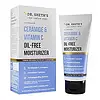What's inside
What's inside
 Key Ingredients
Key Ingredients

 Benefits
Benefits

 Concerns
Concerns

No concerns
 Ingredients Side-by-side
Ingredients Side-by-side

Water
Skin ConditioningGlycerin
HumectantSodium Acrylate/Sodium Acryloyldimethyl Taurate Copolymer
Emulsion StabilisingHydrogenated Polydecene
EmollientTrideceth-6
EmulsifyingSorbitan Laurate
EmulsifyingCetearyl Alcohol
EmollientCaprylic/Capric Triglyceride
MaskingSaccharide Isomerate
HumectantCitric Acid
BufferingSodium Citrate
BufferingBehenyl Alcohol
EmollientSorbitan Stearate
EmulsifyingSucrose Cocoate
EmulsifyingDicetyl Phosphate
EmulsifyingCeteth-10 Phosphate
CleansingCyclopentasiloxane
EmollientPhenyl Trimethicone
Skin ConditioningDimethiconol
EmollientC12-15 Alkyl Benzoate
AntimicrobialDimethicone Crosspolymer
Emulsion StabilisingPhenoxyethanol
PreservativeEthylhexylglycerin
Skin ConditioningXylitylglucoside
HumectantAnhydroxylitol
HumectantXylitol
HumectantAvena Sativa Kernel Flour
AbrasiveSodium Hyaluronate
HumectantPanthenol
Skin ConditioningCeramide 3
Skin ConditioningCeramide 6 Ii
Skin ConditioningCeramide 1
Skin ConditioningPhytosphingosine
Skin ConditioningCholesterol
EmollientSodium Lauroyl Lactylate
EmulsifyingCarbomer
Emulsion StabilisingXanthan Gum
EmulsifyingDipentaerythrityl Tetrahydroxystearate/Tetraisostearate
Skin ConditioningWater, Glycerin, Sodium Acrylate/Sodium Acryloyldimethyl Taurate Copolymer, Hydrogenated Polydecene, Trideceth-6, Sorbitan Laurate, Cetearyl Alcohol, Caprylic/Capric Triglyceride, Saccharide Isomerate, Citric Acid, Sodium Citrate, Behenyl Alcohol, Sorbitan Stearate, Sucrose Cocoate, Dicetyl Phosphate, Ceteth-10 Phosphate, Cyclopentasiloxane, Phenyl Trimethicone, Dimethiconol, C12-15 Alkyl Benzoate, Dimethicone Crosspolymer, Phenoxyethanol, Ethylhexylglycerin, Xylitylglucoside, Anhydroxylitol, Xylitol, Avena Sativa Kernel Flour, Sodium Hyaluronate, Panthenol, Ceramide 3, Ceramide 6 Ii, Ceramide 1, Phytosphingosine, Cholesterol, Sodium Lauroyl Lactylate, Carbomer, Xanthan Gum, Dipentaerythrityl Tetrahydroxystearate/Tetraisostearate
Water
Skin ConditioningCaprylic/Capric Triglyceride
MaskingGlycerin
HumectantSodium Acrylates Copolymer
Coconut Alkanes
EmollientDimethicone
EmollientAmber Extract
Skin ConditioningTocopheryl Acetate
AntioxidantTerminalia Ferdinandiana Fruit Extract
AntioxidantLaminaria Digitata Extract
Skin Protecting3-O-Ethyl Ascorbic Acid
Skin ConditioningPhenoxyethanol
PreservativeLecithin
EmollientCetyl-Pg Hydroxyethyl Palmitamide
Skin ConditioningCeramide 1
Skin ConditioningCeramide 2
Skin ConditioningCeramide 3
Skin ConditioningCeramide 4
Skin ConditioningCeramide 6 Ii
Skin ConditioningWithania Somnifera Root Extract
Skin ConditioningDisodium EDTA
Ethylhexylglycerin
Skin ConditioningWater, Caprylic/Capric Triglyceride, Glycerin, Sodium Acrylates Copolymer, Coconut Alkanes, Dimethicone, Amber Extract, Tocopheryl Acetate, Terminalia Ferdinandiana Fruit Extract, Laminaria Digitata Extract, 3-O-Ethyl Ascorbic Acid, Phenoxyethanol, Lecithin, Cetyl-Pg Hydroxyethyl Palmitamide, Ceramide 1, Ceramide 2, Ceramide 3, Ceramide 4, Ceramide 6 Ii, Withania Somnifera Root Extract, Disodium EDTA, Ethylhexylglycerin
 Reviews
Reviews

Ingredients Explained
These ingredients are found in both products.
Ingredients higher up in an ingredient list are typically present in a larger amount.
This ingredient is an emollient, solvent, and texture enhancer. It is considered a skin-softener by helping the skin prevent moisture loss.
It helps thicken a product's formula and makes it easier to spread by dissolving clumping compounds.
Caprylic Triglyceride is made by combining glycerin with coconut oil, forming a clear liquid.
While there is an assumption Caprylic Triglyceride can clog pores due to it being derived from coconut oil, there is no research supporting this.
Learn more about Caprylic/Capric TriglycerideCeramide 1 is a type of Ceramide.
Our skin is made up of ceramides. Ceramides have several roles, including:
This ceramide has since been retired and replaced with Ceramide EOP.
Learn more about Ceramide 1Ceramide 3 is a form of ceramide and now goes by Ceramide NP.
Ceramides are intercellular lipids naturally found in our skin that bonds dead skin cells together to create a barrier. They are known for their ability to hold water and thus are a great ingredient for dry skin.
Using ceramides in your skincare routine can help reinforce your skin barrier by helping the skin stay hydrated.
If you would like to eat ceramides, sweet potatoes contain a small amount.
Read more about other common types of ceramides here:
Ceramide AP
Ceramide EOP
Ceramide 6 II is a type of Ceramide.
Ceramides are intercellular lipids naturally found in our skin that bonds dead skin cells together to create a barrier. They are known for their ability to hold water and thus are a great ingredient for dry skin.
Ethylhexylglycerin (we can't pronounce this either) is commonly used as a preservative and skin softener. It is derived from glyceryl.
You might see Ethylhexylglycerin often paired with other preservatives such as phenoxyethanol. Ethylhexylglycerin has been found to increase the effectiveness of these other preservatives.
Glycerin is already naturally found in your skin. It helps moisturize and protect your skin.
A study from 2016 found glycerin to be more effective as a humectant than AHAs and hyaluronic acid.
As a humectant, it helps the skin stay hydrated by pulling moisture to your skin. The low molecular weight of glycerin allows it to pull moisture into the deeper layers of your skin.
Hydrated skin improves your skin barrier; Your skin barrier helps protect against irritants and bacteria.
Glycerin has also been found to have antimicrobial and antiviral properties. Due to these properties, glycerin is often used in wound and burn treatments.
In cosmetics, glycerin is usually derived from plants such as soybean or palm. However, it can also be sourced from animals, such as tallow or animal fat.
This ingredient is organic, colorless, odorless, and non-toxic.
Glycerin is the name for this ingredient in American English. British English uses Glycerol/Glycerine.
Learn more about GlycerinPhenoxyethanol is a preservative that has germicide, antimicrobial, and aromatic properties. Studies show that phenoxyethanol can prevent microbial growth. By itself, it has a scent that is similar to that of a rose.
It's often used in formulations along with Caprylyl Glycol to preserve the shelf life of products.
Water. It's the most common cosmetic ingredient of all. You'll usually see it at the top of ingredient lists, meaning that it makes up the largest part of the product.
So why is it so popular? Water most often acts as a solvent - this means that it helps dissolve other ingredients into the formulation.
You'll also recognize water as that liquid we all need to stay alive. If you see this, drink a glass of water. Stay hydrated!
Learn more about Water